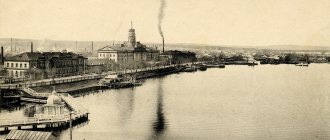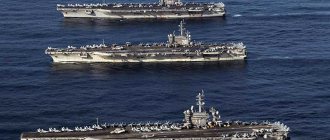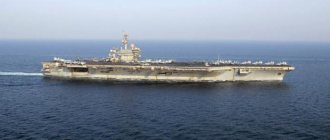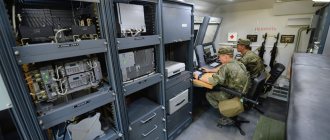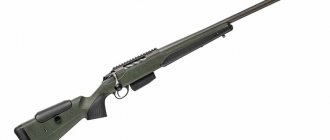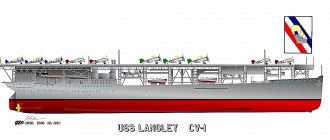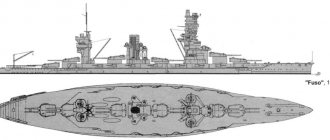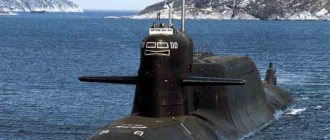The role of the Essex aircraft carriers in the history of the US Navy
The Essex class is a series of heavy aircraft carriers of the US Navy that were built at the beginning of World War II. Main purpose: deployment of strike aircraft near enemy shores. At first, the designers planned to limit themselves to one such ship. However, US involvement in hostilities from late 1941 required the construction of a series of aircraft carriers. They formed the main backbone of the US Navy strike group in the 50-70s of the last century.
Cultural works[edit]
the Essex tragedy
not only inspired much of American writer Herman Melville's classic
1851 Moby-Dick
- The theatrical documentary film Revenge of the Whale
(2001) was produced and aired on September 7, 2001 on NBC. [29] -
's 2004 string quartet What the Whaleship Saw [thirty] - The television film The Whale
(2013) was shown on BBC One on 22 December, featuring an elderly Thomas Nickerson (played by Martin Sheen) narrating events in
Essex
. Charles Furness played the younger Nickerson, Jonas Armstrong played Owen Chase, and Adam Rayner played Captain Pollard. - The 2015 film In the Heart of the Sea,
directed by Ron Howard, was based on Philbrick's book. Chris Hemsworth played Owen Chase and Benjamin Walker played Captain Pollard. Brendan Gleeson and Tom Holland portrayed the older and younger Nickerson, respectively.
Design features of Essex-class aircraft carriers
They differed from their predecessors, ships of the USS Yorktown type, by their large dimensions. Another feature was the division of parts of the ship located below the waterline into separate compartments. This made it possible to confidently stay afloat, even in case of emergency flooding of some of them. Almost along the entire perimeter, the bottom consisted of three layers. Thereby increasing unsinkability.
The innovation was the design of a wider midsection, pointed contours in combination with a large camber of the frames. This significantly reduced the counter resistance of water during movement. Geometrically, the length of aircraft carriers to their width was in proportion 8 to 8.1.
The weak link remained the deck and hangar for the aircraft. During a strong storm, this superstructure violated the geometry, subjecting the bow to greater load, as a result of which the latter could be damaged when encountering very large waves.
dimensions
The expansion of the runway was positive, including by reducing the size of the “island” superstructure, as well as reducing the sections of the deck where the anti-aircraft guns were located. The practice of naval combat led to the fact that the design bureau in 1943 decided to change the length of aircraft carriers from 262.8 to 270.8 meters. This helped to increase the firing angle of the guns, which were placed in the bow and stern of the ship.
Booking
The installed armor reliably resisted damage from 152 mm caliber shells fired from a distance of 10-17 kilometers, as well as the consequences of a bomb explosion weighing up to 1000 pounds. The side armor has become thicker. Thickening the deck armor prevented damage to the engine room located underneath.
Reservation was provided by 102 mm plates, which were installed on a steel structure. The 155-meter belt protection provided 62% waterline protection. The covering of the citadel consisted of slabs 37 mm thick; the hangar was covered with 64 mm armor. Separately, with 64 and 37 mm plates, the steering compartment and wheelhouse were protected, respectively. The steering compartment also had 102 mm armored walls.
The total weight of the armor metal was 996.7 tons. To absorb the shock wave in cases of underwater attack, the fuel was located in two external compartments, followed by empty ones that served as an expansion chamber. This design successfully resisted small aerial bombs, but could not create an obstacle to the destruction of large 610 mm torpedoes.
Power plant
The aircraft carriers were powered by four units and eight modernized steam boilers compared to those installed on Yorktown.
Across the ocean on whaleboats
It was clear that waiting for rescue on the spot was a utopia. It was decided to get out on our own, the only question was where. the decision became disastrous. Captain Pollard proposed moving west to the Marquesas Islands, which were 2200 km away. But Chase and the crew were wary of the cannibals who were rumored to inhabit the islands and voted to move east to South America. True, the problem was the trade winds, because of which it was necessary to first travel 1,800 km to the south, and only then would it be possible to turn east, using the westerly wind, and travel another 5,500 km.
The main problem was the lack of fresh water. In addition, most of the provisions were in sea water, which made it even more salty, which in turn increased thirst. . And for two weeks people ate salted foods, rinsing their mouths with sea water and drinking their own urine. The whaleboats, which had already received previous damage, and were also not intended for long-term navigation in principle, constantly leaked, which made life even more difficult for people. The crew of one of the boats somehow had to tilt their boat so that the hole appeared out of the water and the people from the second whaleboat could repair it.
There were literally a few hours left before the first deaths from thirst, when people noticed the land. It turned out to be the uninhabited Henderson Island. Literally 192 kilometers to the southwest there was another island, Pitcairn, where the last participants in the mutiny on the Bounty lived and where those in distress would receive help. But they were unlucky once again...
On the island there was a small source of fresh water, birds and their eggs, and crabs. In just a week, the sailors almost completely exhausted the island's resources and on December 26 decided to move on, fearing starvation. But Seth Weeks, William Wright and Thomas Chappell decided to stay on the island. The remaining crew members sailed on New Year's Eve to Easter Island, promising to send help for those remaining. After only 3 days, the supplies of birds and crabs from the island ran out, and only a little bread from the Essex remained on the whaleboats. On January 4, the sailors realized that they would not be able to get to Easter Island and headed to the island of Mas a Tierra, which was 3,367 km away, and there would only be 776 km left in South America.
Very soon people in the boats began to die. Owen Chase and George Pollard were in different boats. Chase lost his friend, second mate Matthew Joy, on January 10th. The next day, the boats were caught in a strong squall, causing Owen's whaleboat to become separated from the others. On January 18, another sailor died, who, like Joy, was buried at sea, sewn into his own clothes. The body of Isaac Cole, who died on February 8, was left in the boat - the survivors decided to take extreme measures - cannibalism. On February 15, the food in the boats ran out...
In the boats of Captain Pollard and coxswain Obed Hendrix, things went even worse; by January 14, food ran out in Hendrix's boat, and 21 in Pollard's whaleboat. On January 20 it was decided to consume the body of the deceased Lawson Thomas. The same fate befell Charles Shorter, Isaiah Shepard and Samuel Reed, who died one after the other. On January 28, the boats were separated. Obed Hendricks, Joseph West and William Bond, who remained in one of them, were never seen again. They are all believed to have disappeared at sea.
The next stage of famine began on February 1. In Pollard's boat, it was decided to draw lots to see who would have to give their life to save the others. Owen Coffin got the short straw. This was the captain's cousin, whom he promised to protect. Pollard wanted to take the lot himself, but Coffin decided everything in his own way. His remains allowed Pollard, Barzillau Ray and Charles Ramsdell to hold out for several more days. Ray died on February 11, clearing the lot of those remaining. Next, Pollard and Ramsdale gnawed at the bones of the dead.
Weapon equipment
The aircraft carriers' anti-aircraft weapons, their control system and the type of ammunition were also modernized. The number of trunks has been increased. At the same time, the firing angle was also expanded in comparison with previous models. Total number of weapons:
- 12 guns with a caliber of 127 millimeters, of which 8 were on the deck, allowing fire on both flanks;
- 32 units of 40 mm Bofors type, instead of the previously used 12.7 mm machine guns;
- 46 20 mm cannons, which were aimed at targets individually.
40 mm Bofors gun
Radar installations
Pioneering developments in electronics provided enormous benefits to the US military industry. The first aircraft carriers were equipped with two radar installations of the “SK” and “SC2” types, which easily detected targets at a distance of up to 80 miles, paired “MK4” radars, and a radio beacon mounted on a mast. In addition, “SG” antenna devices were used to identify surface targets. During the modernization process, 5 radars were already installed on later models of ships. And by the end of the war, devices appeared to create artificial interference with the operation of enemy equipment.
Electrical equipment
To generate electrical energy, 4 generators were used, each of which produced up to 1250 kW of power. In addition, a pair of emergency generators of similar power were installed in separate compartments. An innovation was the installation for refueling at sea. Thanks to this equipment, the ship could sail autonomously for a month and a half. And reserve stocks extended this period to 16 weeks.
CONTENT
- 1 Ship and crew
- 2 Final voyage 2.1 Depletion of whaling grounds
- 2.2 Repairs and resupply in the Galapagos Islands
- 2.3 Sealand
- 2.4 Whale attack
- 3.1 Landfall
Type of aircraft carried
On average, the Essex aircraft carriers were equipped to transport about 100 aircraft. A typical air group in terms of quantitative composition was as follows:
- from 20 to 49 anti-submarine aircraft of the S2 Tracker type;
- from 16 to 20 units. anti-submarine helicopters SH3 Sia King, or HSS1N Siabat;
- 4-5 long-range aircraft of the E1 Tracer type, as well as an AD5W Skyraider. Also, as a rule, one C1 Trader type transport aircraft was transported on deck, but not always.
Airplane S2 Tracker
Serial production of ships
In total, within five years, from 1940 to 45, 24 ships were launched. Thanks to this, this type entered the history of naval aviation as the most widespread series in history. It is noteworthy that they successfully went through the entire war in full force. Despite the damage received during the battles, they continued to serve after major repairs of individual components.
When the war ended, 14 ships were transferred to the naval reserve, from where they never returned to service. Those that remained have undergone modernization. Since the beginning of the 1970s, due to increasing demands on performance, it was decided to decommission this type of ship from service due to obsolescence. Only one aircraft carrier, the Lexington, survived until 1992, serving as a training model for the training of future sailors. Thus, the existence of the ships of the Essex family, forever included in the history of the American battle flotilla, ceased to exist.
Pioneer "Essex"
The aircraft carrier USS Essex (CV/CVA/CVS-9) became the first in the family of ships of this type. It took a little more than a year to build the ship at Newport Shipbuilding: from the spring of 1941 until its launch on July 31, 1942.
Consequences[edit]
Owen Chase in later life
Thomas Nickerson in the 1870s
Pollard returned to sea in early 1822 to command the whaling ship Two Brothers
.
She was wrecked on the shoals of a French frigate in a storm off the coast of Hawaii on her maiden voyage, after which she joined a merchant ship that was wrecked off the Sandwich Islands (Hawaiian Islands) shortly thereafter. By this time, Pollard was considered a "Jonah" (loser) and no shipowner trusted him to sail a ship again, so he was forced to resign. He subsequently became Nantucket's night watchman. It is reported that every 20 November he locked himself in his room and fasted in memory of the men of Essex
. [15] He died in Nantucket on January 7, 1870, at the age of 78.[22]
First Mate Owen Chase returned to Nantucket on June 11, 1821, to find that he had a 14-month-old daughter whom he had never met. Four months later he completed his account of the disaster, Narrative of the Most Extraordinary and Sad Wreck of the Whale Ship Essex.
;
Herman Melville used it as one of the inspirations for his novel Moby-Dick
(1851).
In December, Chase served as first mate of the whaling ship Florida
, and then as captain of
the Winslow
on each subsequent voyage until he could afford to build his own whaling ship,
the Charles Carrol.
.
Chase remained at sea for 19 years, returning home briefly every two or three years, each time having a child. His first two wives died while he was at sea. He divorced his third wife when he discovered that she had given birth 16 months after he last saw her, although he subsequently raised the child as his own. In September 1840, two months after the divorce, he married for the fourth and last time and retired from whaling. [15] Memories of the harrowing ordeal at Essex haunted
Chase, and he suffered from terrible headaches and nightmares. He later began hiding food in the attic of his Nantucket home on Orange Street and was eventually institutionalized. [23] He died in Nantucket on March 7, 1869 at the age of 73.
Young, Thomas Nickerson, became a captain in the merchant service and late in his life wrote his own account of the sinking entitled "The Loss of the Essex by a Whale and the Trial of the Crew in Open Boats"
. Nickerson wrote this account 56 years after the sinking, in 1876, and it was lost until 1960; The Nantucket Historical Association published it in 1984. He died in February 1883, aged 77.
The remaining surviving crew members met different fates:
- Thomas Chapple died of a plague fever in Timor while working as a missionary. [24]
- William Wright died in a hurricane in the West Indies. [25]
- Charles Ramsdell died in Nantucket on July 8, 1866, at the age of 62. [26]
- Benjamin Lawrence died in Nantucket on March 28, 1879, at the age of 80. [27]
- Seth Weeks died on September 12, 1887 in Barnstable County, Massachusetts, the last survivor of Essex
. [28]
Technical equipment
The length was 265.9 meters, width: 45 meters, height from the keel to the take-off deck: 24.9 meters. The ship was quite maneuverable for its time. The displacement was 23,785 dry and 34,881 tons laden.
Model of the aircraft carrier "Lexington"
Armor
The ship was reliably protected by 64-102 mm armor around the perimeter. On the beams and tiller compartments: 64 to 102 mm, 37 millimeters of steel protected the sailors in the conning tower.
Engine
A power of 150 thousand horsepower and a maximum speed of 33 knots was created by 4 propulsion engines, eight Babcock-Wilks boilers and four Westinghouse turbines. A one-time refueling was enough to cover 15,000 nautical miles at a speed of 15 knots. The carrying capacity and capacity made it possible to transport from 91 to 103 combat aircraft.
Crew
The staff provided that 2,386 people would serve, of which 215 were officers. However, this quantity turned out to be small. Therefore, the number of employees was increased to 3106 people, and officers - to 226.
Combat strength was:
- 6 double-barreled units of 127 mm MK12 guns;
- 8 four-barrel, 40 mm caliber, Bofors MK2 brand;
- 46 single-barrel, 20 mm Oerlikon MK4 barrels.
Oerlikon MK4 gun
Other ships attacked by whales[edit]
« Essex"
- not the only known ship to be attacked by a whale:
- In 1807, a whale attacked
and sank the Union [31] - In 1835, Pusey Hall
was attacked. [32] - In 1836, whales attacked Lydia
and
two generals
. [32] - In 1850, Pocahontas
. [32] - On August 20, 1851, a whale sank Anne Alexander
. - In 1852, a whale sank the Crusader
. [33] - In 1855 the whale sank Waterloo
. [33] - On June 15, 1972, a pod of killer whales sank the 13-meter schooner Lucette
. - On July 7, 1999, a humpback whale sank the 73-foot (22 m), 111-year-old Merlin
in Whale Bay, Baranof Island, Alaska. [34]
Combat service
On December 31 of the same year he began military service in the Pacific Ocean. It was repeatedly damaged and underwent modernization until the beginning of 1947, when it was transferred to the naval reserve. There it underwent a major restructuring. After the introduction of the return to service, there was an accident that led to extensive damage, the loss of 10 aircraft, and the death of sailors.
After returning to service again, he fought off the Korean coast. Then redeployed to the Atlantic, and then to the Mediterranean. He participated in the Lebanese War, in Beirut, in Cuba, and ensured the landing of the Apollo series spacecraft.
Aircraft carrier-museum Intrepid "USS Intrеrid СV"
Sources [edit]
- Chase, Owen (1821). A story about the most unusual and sad shipwreck of the whale ship "Essex". New York: W. B. Gilley. OCLC 12217894.
- Chase, Owen (1965) [1821]. Haverstick, Iola; Shepard, Betty (ed.). Wreck of the whaling ship "Essex". New York: Harcourt, Brace & World, Inc.
- Heffernan, Thomas Farel (1990) [1981]. Slab at the Whale: Owen Chase and Essex. Middletown, CT: Wesleyan University Press. ISBN 0819562440.
- Philbrick, Nathaniel (2001). In the Heart of the Sea: The Tragedy of the Whaling Ship Essex. New York: Penguin Books. ISBN 0-14-100182-8. OCLC 46949818. See also " In the Heart of the Sea: The Tragedy of the Whaleship Essex"
Links[edit]
- ^ abcd "Essex". Bowling Green State University
. Retrieved April 9, 2022. - ^ ab "National Registry Information System". National Register of Historic Places
. National Park Service. July 9, 2010 - ^ abcdefgh "Historical Description of USS Essex". Minnesota Historical Society
. Retrieved April 9, 2022. - ^ ab "USS Essex (+1931)". Crash site
. Retrieved April 9, 2022. - ^ ab "Lake Superior Shipwreck - USS Essex". Minnesota Historical Society
. Retrieved April 9, 2022. - ^ ab "Statement of Significance of USS Essex". Minnesota Historical Society
. Retrieved April 9, 2022. - ^ abcdefghij "USS Essex-Construction and Career". Minnesota Historical Society
. Retrieved April 9, 2022. - Essex (wooden steamer), DANFS
- ^ ab "Essex, USS (1874, naval vessel)". A Maritime History of the Great Lakes
. Retrieved April 9, 2022. - "Medal of Honor Recipients—Intermediate Awards, 1871–1898". Medal of Honor
. US Army Center of Military History. August 5, 2010. Retrieved August 20, 2010. - ^ abcdef "USS Essex - Description of the Wreck". Minnesota Historical Society
. Retrieved April 12, 2022. - "The USS Essex Shipwreck". Minnesota National Register Database
. Minnesota Historical Society. 2009. Retrieved August 4, 2018.
This article incorporates text from the public domain.
Dictionary of American Naval Combat Ships
. The recording can be found here.
